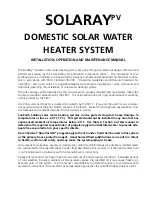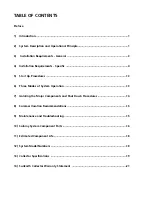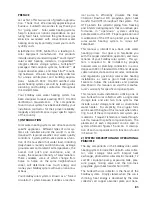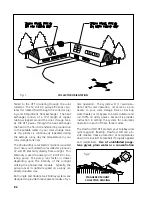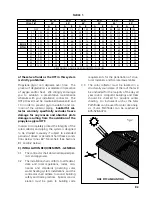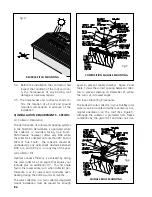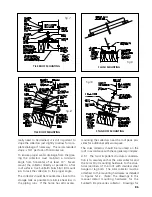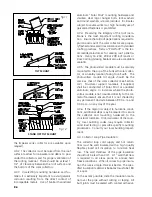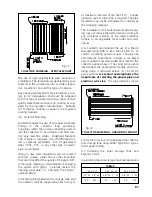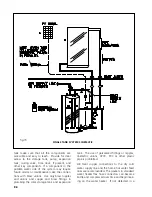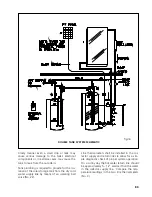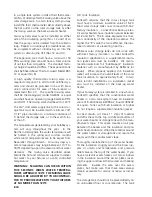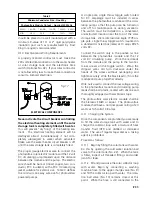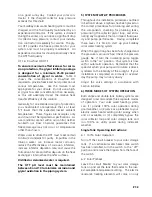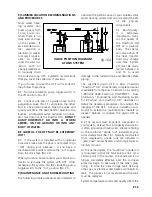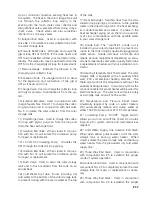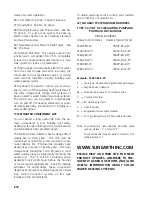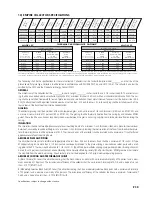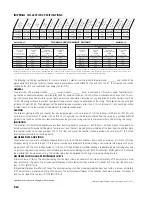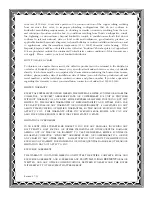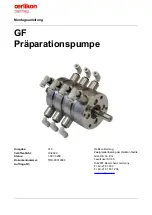
P.10
In a single tank system install a third thermome-
ter (No. 3) directly after the mixing valve above the
solar storage tank. In a two tank system you may
install the third thermometer either directly above
the hot outlet on the solar storage tank or after
the mixing valve on the back-up water heater.
Two way ball valves must be installed on either
side of the circulating pump (Nos. 12 and 14) so
that the pump can be isolated from the collector
loop. Repairs or routine system maintenance can
be completed without introducing air into the
system or draining the HTF (Nos.12 and 14).
The expansion tank shall have a minimum 150
PSIG working pressure and have a total volume
of not less than 4.4 gallons. The standard facto-
ry charge should be 40 PSIG. The expansion tank
shall be Rheem/Ruud Therm-X-Guard Model RRT-
12 or equal (No. 8).
A high quality thermostatic mixing valve is a
required component in all OG-300 certified sys-
tems and should be plumbed in line with brass
union connections for ease of future repair or
replacment (No. 31). The specified mixing valve
shall be the Heatguard model HGBASE or equal
and shall have an operating range between 95°F
and 140°F. The mixing valve shall be set to 120°F.
The 3/4" cold water supply line to the solar stor-
age tank must be insulated with minimum 7/8"
X 1/2" pipe insulation to a minimum distance of
5' behind the storage tank, or to the wall if clos-
er than 5'.
The temperatures generated by your SolaRay sys-
tem will vary throughout the year. In the
Northern Hemisphere the water temperature will
be hottest in the spring and summer months
while cooler temperatures are to be expect from
November through March. On sunny days sys-
tem temperatures may range between 110ºF to
180ºF depending upon the season and hot water
demand. The mixing valve described above
blends the hot and cold water supplies to deliver
hot water to your fixtures at a safe, controlled
temperature.
WARNING: SCALDING CAN OCCUR WITHIN
FIVE SECONDS WHEN WATER TEMPERA-
TURES APPROACH 140ºF. THE MIXING VALVE
SHOULD BE ADJUSTED BY YOUR CONTRAC-
TOR TO PROVIDE WATER TO YOUR FIXTURES
AT NO MORE THAN 120ºF.
4.9 Tank Insulation
SunEarth requires that the solar storage tank
must have a minimum insulation value of R-20.
Most solar storage tanks now come with R-16.7
factory insulation. Conventional back-up elec-
tric water heaters have insulation values between
R-12 and R-20. The R value expresses the ther-
mal conductivity of the insulation material. The
higher the "R"value the more effective the insu-
lation material is at preventing heat loss.
Whereas solar storage tanks do not come with
sufficient factory insulation to meet SunEarth’s
insulation specification, a supplemental insula-
tion jacket also must be installed. We recom-
mend an aluminum foil "bubble-pack" insulation
material such as manufactured by Reflectix (or
equal). When properly applied, the insulation
jacket will increase the overall level of the solar
tank insulation to approximately R-22. In two
tank retrofit installations an installation jacket
also must be installed on the back-up water
heater.
If your Solaray system is installed in a new home,
SunEarth specifies that the conventional water
heater in a two tank system have an insulation
value of R-20 (Rheem 82VR52-2, Ruud EVR5202
or equal). Tanks with R-20 insulation or higher
do not require a supplemental insulation jacket.
For best results, cut three 1" strips of material
and affix these to the top, middle and bottom of
your water heater or storage tank with the man-
ufacturer’s tape. This space creates an air gap
between the heater and the insulation and pre-
vents heat conduction. Wrap the material around
the water heater or storage tank and secure the
seams with the manufacturer’s tape.
Thoroughly insulate the top of the water heater.
Fit the insulation snuggly around the brass nip-
ples or unions and temperature and pressure
relief valve on the top of the water heater. If you
have an electric water heater, cut two windows
in the insulation around the access plates cover-
ing the upper and lower thermostats and heating
elements. Insulate the area over the assess
plates, but make sure that these areas always
remain accessible for service or repair as neces-
sary.
The storage tank should not be placed directly on
an uninsulated floor or concrete slab. The tank


